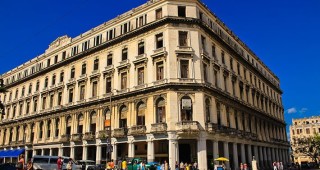Factoría Habana is an experimental center for present-day artistic creation. The institution, which is ascribed to the City Historian’s Office, seeks to become a bridge between Latin American and European art.
Factoría Habana is an experimental center for present-day artistic creation. The institution, which is ascribed to the City Historian’s Office, seeks to become a bridge between Latin American and European art.

 4
4The former 18th-century mansion of Claudio Martínez de Pinillos, Count of Villanueva, leader of Cuban Creole society in the 19th century, was restored in the 1990s to create a charming and comfortable …
 ColonialAdmission: n-aMercaderes #202, e/ Lamparilla y Amargura, Habana Vieja
ColonialAdmission: n-aMercaderes #202, e/ Lamparilla y Amargura, Habana Vieja 
 4
4Located on Avenida de los Presidentes, this is one of the most lavish monuments in the city. Its bas-reliefs show important moments in the life of José Miguel Gómez, president of the Republic of Cuba …

 4
4This tiny and architecturally authentic Greek orthodox church (Cuba’s only one) stands in the Jardín Madre Teresa de Calucuta and was consecrated by Bartholomew I Ecumenical Patriarch and Archbishop o …
 ColonialAdmission: n-aChurruca esq. a San Pedro, Habana Vieja
ColonialAdmission: n-aChurruca esq. a San Pedro, Habana Vieja 
 4
4Avenida Paseo, with large trees on both sides and a wide promenade with topiary and benches, is one of Havana’s most classy streets. There are luxurious mansions on both sides of the street, including …

 4
4Rising over the plaza off the southeast corner is Palacio Cueto. Built in 1906 with an elaborately adorned façade featuring griffins, satyrs and other mythical figures, it’s reminiscent of the moderni …
 Art NouveauMercaderes esq. a San Ignacio, Habana Vieja
Art NouveauMercaderes esq. a San Ignacio, Habana Vieja 
 4
4The Lonja del Comercio, which first opened on March 1909, is angled obliquely to the square on its northern side. It was built in eclectic-style by the architectural firm of Purdy and Henderson as a c …
 EclecticOpen: 9am-5pm Mon-SunLamparilla, esq. a Oficios, Habana Vieja
EclecticOpen: 9am-5pm Mon-SunLamparilla, esq. a Oficios, Habana Vieja 
 4
4In 1689, Bishop Diego Evelino de Compostela founded San Ambrosio, an unpretentious school for boys, located on Tejadillo Street and adjacent to the Jesuit church under construction at the time. When t …
 BaroqueAdmission: FreeCuba e/ Chacón y Empedrado, Habana Vieja
BaroqueAdmission: FreeCuba e/ Chacón y Empedrado, Habana Vieja 
 4
4This beautiful church and convent was built in Neo=\-Gothic style in 1874 and was a private girls’ school until 1961. The patio and chapel have beautiful wooden ceilings, notable stained-glass windows …
 OtherOpen: 8am-5pm Mon-Fri; 5-7pm Sat; 8-11am SunSan Lázaro #805 entre Oquendo y Lucena
OtherOpen: 8am-5pm Mon-Fri; 5-7pm Sat; 8-11am SunSan Lázaro #805 entre Oquendo y Lucena 
 5
5While the Floridita has its detractors, it is probably worth stopping in for a daiquiri just because it is there. It has certainly been around the block since it first opened its doors over 200 years …
 Traditional BarAdmission: FreeOpen: Open 11am-midnight daily
Traditional BarAdmission: FreeOpen: Open 11am-midnight daily $48 - $83ROOMS: 25Obispo #557, esq. a Monserrat, Habana Vieja
$48 - $83ROOMS: 25Obispo #557, esq. a Monserrat, Habana Vieja 
 4
4Owned by Julián de Zulueta, construction work began in 1890 according to the project designed by architect Pedro Tomé Veracruisse; however, still unfinished, it was sold to Andrés Gómez Mena, who comp …
 EclecticAdmission: n-aLimited by Neptuno, Monserrate, Obispo and Zulueta Streets, Habana Vieja
EclecticAdmission: n-aLimited by Neptuno, Monserrate, Obispo and Zulueta Streets, Habana Vieja